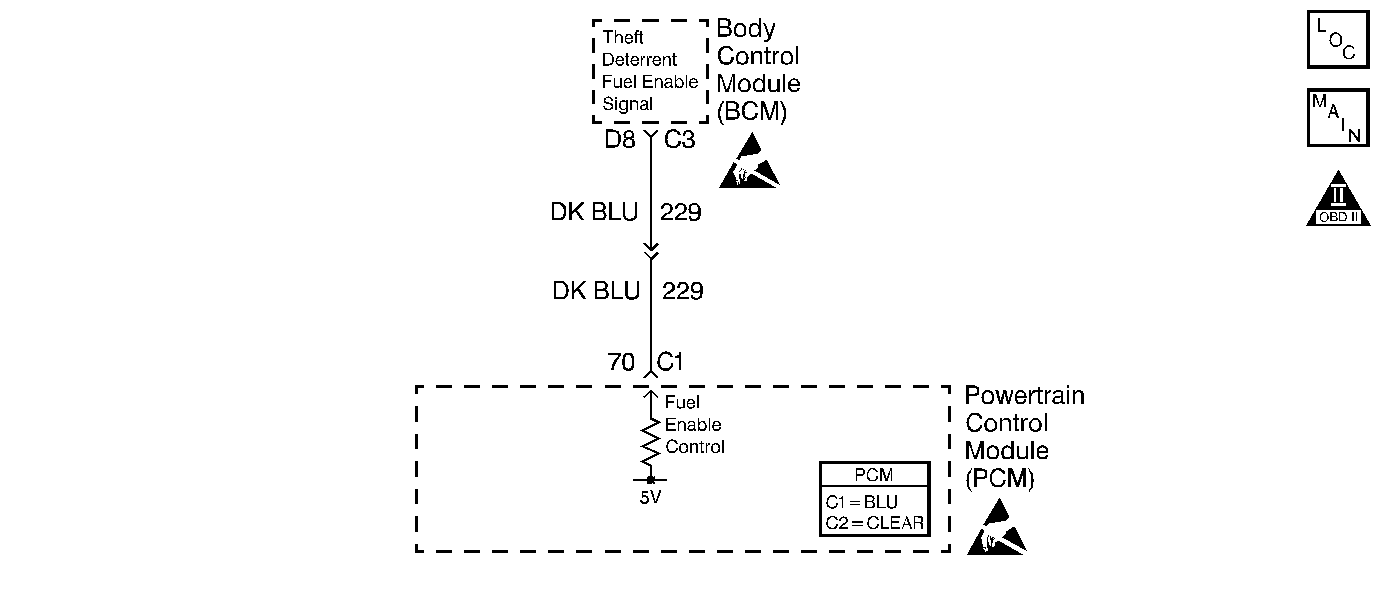
Circuit Description
The Body Control Module (BCM) produces the Theft Deterrent Fuel Enable signal when ignition is ON and the proper key resistor pellet is sensed. The PCM monitors the Fuel Enable signal during crank. If the proper signal is present on the Theft Deterrent Fuel Enable circuit, the PCM enables fuel delivery and starter operation to allow the engine to start. If the PCM detects that the fuel enable signal is not present or incorrect while an attempt is made to start the engine, DTC P1629 will be set. The engine will not start and the starter motor will be disabled. This conditions will occur if the problem also affects inputs to the BCM. Refer to Vehicle Theft Deterrent System for further diagnosis.
Conditions for Running the DTC
| • | DTC P1626 is not present. |
| • | An attempt is made to start the engine. |
Conditions for Setting the DTC
The PCM detects an incorrect signal on the Theft Deterrent Fuel Enable Circuit.
Action Taken When the DTC Sets
| • | The PCM will not illuminate the malfunction indicator lamp (MIL). |
| • | The PCM will store conditions which were present when the DTC set as Failure Records data only. This information will not be stored as Freeze Frame data. |
Conditions for Clearing the MIL/DTC
| • | A History DTC will clear after 40 consecutive warm-up cycles have occurred without a malfunction. |
| • | The DTC can be cleared by using the scan tool Clear Info function. |
Diagnostic Aids
An intermittent may be caused by a poor connection, rubbed through wire insulation or a wire broken inside the insulation. Check for:
| • | Poor connection at PCM - Inspect harness connectors for the following items: |
| - | Backed out terminals |
| - | Improper mating |
| - | Broken locks |
| - | Improperly formed or damaged terminals |
| - | Poor terminal to wire connections |
| • | Damaged harness - Inspect the wiring harness for damage. If the harness appears to be OK, disconnect the vehicle theft deterrent module, turn the ignition ON and observe a digital multimeter connected to the theft deterrent fuel enable circuit at the vehicle theft deterrent module harness connector while moving connectors and wiring harnesses related to the vehicle theft deterrent system. A change in voltage will indicate the location of the malfunction. |
Review the Freeze Frame/Fail Records vehicle mileage since the diagnostic test last failed. This may help determine how often the condition that caused the DTC to be set occurs.
Test Description
Number(s) below refer to the step number(s) on the Diagnostic Table.
Step | Action | Value(s) | Yes | No |
|---|---|---|---|---|
1 | Did you perform the Powertrain On-Board Diagnostic (OBD) System Check performed? | -- | ||
2 |
Important:: Before continuing, ensure that the vehicle battery is fully charged. Attempt to start the engine. Does the engine crank? | -- | Go to Content Theft Deterrent (CTD) System Check in Body and Accessories | |
3 |
Does the voltage measure at or near the specified value? | 5V | ||
4 |
Does the frequency measure within the specified range? | 40-60 Hz | ||
5 |
Does the vehicle start and continue running? | -- | Go to Diagnostic Aids | |
6 | Test the vehicle theft deterrent fuel enable circuit for an open, short to ground, or short to voltage. Refer to Wiring Repairs . Did you find and correct the condition? | -- | ||
7 | Inspect the theft deterrent fuel enable circuit for a faulty connection at the PCM. Refer to Intermittents and Poor Connections Diagnosis and Connector Repairs . Did you find and correct the condition? | -- | ||
8 | Inspect for faulty connections at the BCM. Refer to Intermittents and Poor Connections Diagnosis and Connector Repairs . Did you find and correct the condition? | -- | ||
|
Important:: The replacement PCM must be programmed. Refer to Powertrain Control Module Replacement/Programming . Replace the PCM. Did you complete the replacement? | -- | -- | ||
10 | Replace the BCM. Refer to Body Control Module Replacement . Did you complete the replacement? | -- | -- | |
11 |
Does the scan tool indicate Active? | -- | System OK |
